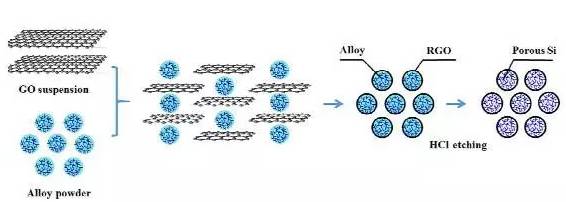Introduction to Silicon-Based Anode Materials
Historical and Industrial Context
Silicon-based anodes have long been heralded as the future of battery materials, primarily due to their exceptional energy density, cost-effectiveness, and rapid charging capabilities. The journey of silicon anodes from laboratory curiosity to industrial application began in earnest in 1996, marking the start of extensive research and development efforts. Over the past two decades, the industrialization of silicon anode technology has been steadily accelerating, driven by the concerted efforts of global leaders in the field.
Japan, South Korea, and the United States have emerged as the frontrunners in this technological race, each contributing significantly to the advancement and commercialization of silicon anode materials. These nations have not only invested heavily in research but have also fostered collaborative environments that have spurred innovation and accelerated the transition from prototype to production.
The burgeoning interest in silicon anodes is underscored by their potential to revolutionize battery technology, offering solutions to some of the most pressing challenges in energy storage. As the demand for high-performance batteries continues to surge, driven by the electrification of transportation and the proliferation of portable electronics, the role of silicon anodes is expected to become increasingly pivotal. This burgeoning interest is further evidenced by the significant investments pouring into startups and established players alike, all vying to secure a foothold in this promising market.

Market and Investment Trends
The burgeoning market for next-generation battery technologies has seen a surge in investment, particularly in startups such as Group14, which have garnered significant funding. This influx of capital underscores the high expectations surrounding silicon-based anodes and their potential to revolutionize battery performance.
In addition to these new entrants, traditional anode material enterprises and key industry chain players are also ramping up their investments. These established companies are heavily committing resources to the development and expansion of silicon anode production lines. This strategic shift reflects a broader industry consensus on the future dominance of silicon-based anodes.
| Investor Type | Investment Focus | Impact |
|---|---|---|
| Startups | Innovation and technology development | High market expectations and potential disruption |
| Traditional Enterprises | Production line expansion and technology integration | Ensures scalability and market readiness |
The combined efforts of both new and traditional players are expected to accelerate the commercialization of silicon-based anodes, positioning them as a cornerstone in the evolution of battery technologies.
Challenges in Silicon Anode Technology
Volume Expansion and Its Consequences
Silicon anodes, while promising due to their high energy density, are plagued by significant volume expansion issues. This expansion, which can be as high as 300% during the lithiation process, leads to severe material cracking. This cracking not only compromises the structural integrity of the anode but also results in a substantial loss of battery capacity. Consequently, the longevity and performance of batteries using silicon anodes are severely impacted, raising critical safety concerns.
The consequences of volume expansion are far-reaching. For instance, the repeated expansion and contraction cycles can cause the anode to fracture, leading to the formation of internal shorts and potential thermal runaway. This poses a significant risk to battery safety, which is a paramount consideration in battery design and application. Despite the potential benefits, these challenges have so far limited the mainstream use of silicon anodes to less than 3% doping in commercial batteries. This restriction underscores the urgent need for technological advancements to mitigate these issues and unlock the full potential of silicon-based anodes.

Cost-Effectiveness Dilemma
Traditional silicon anode technologies grapple with a significant cost-performance dilemma. These technologies often demand a substantial 10% increase in production costs, yet they yield only a modest 5% enhancement in overall performance. This imbalance poses a critical challenge for manufacturers aiming to integrate silicon anodes into their battery production lines.
Key Factors Contributing to the Dilemma
-
Material Sourcing and Processing: The procurement and processing of high-quality silicon materials are inherently expensive. The additional steps required to refine and prepare these materials for anode use further escalate costs.
-
Technological Limitations: Current silicon anode technologies are not yet optimized to deliver substantial performance improvements without a proportional rise in costs. This limitation is particularly evident in the trade-offs between energy density and cycle life.
-
Market Dynamics: The high initial costs of silicon anodes deter widespread adoption, particularly in markets where cost-sensitive applications dominate. This reluctance is compounded by the lack of clear, long-term cost reduction strategies.
Impact on Industry Adoption
The cost-effectiveness dilemma has led to a cautious approach among battery manufacturers. While the potential benefits of silicon anodes are well-documented, the current economic realities make it difficult for these technologies to compete with more established anode materials like graphite. This situation has created a barrier to entry for new market entrants and has slowed the pace of innovation in the sector.
Future Prospects
Addressing this cost-performance imbalance is crucial for the future of silicon anodes. Innovations in material science and manufacturing processes are expected to play a pivotal role in reducing costs while enhancing performance. Technologies such as vapor deposition, which offer a more balanced approach to cost and performance, are seen as potential game-changers in overcoming this dilemma. As these technologies mature, they could pave the way for a more widespread and economically viable adoption of silicon anodes in next-generation batteries.

Vapor Deposition Method for Silicon-Carbon Anodes
Process and Benefits
The vapor deposition method for silicon-carbon anodes is a sophisticated process designed to tackle the inherent challenges of silicon-based anodes, particularly the issue of volume expansion. This method begins with the creation of a porous carbon skeleton, which serves as a robust framework that can accommodate the expansion and contraction of silicon during charge and discharge cycles. By integrating silica particles into this skeleton, the method not only stabilizes the structure but also enhances the material's overall conductivity.
The final step involves coating the composite with a thin layer of carbon. This carbon layer acts as a protective shield, preventing the degradation of the silicon particles and further improving the electrical conductivity of the anode. The result is a material that not only addresses the volume expansion issue but also significantly boosts the anode's conductivity, leading to high first-cycle efficiency and outstanding cycling performance.
This method's benefits are manifold. Firstly, it effectively mitigates the volume expansion problem that has historically plagued silicon anodes, thereby enhancing the material's durability and safety. Secondly, the enhanced conductivity translates to faster charging times and more efficient energy storage, making it a superior choice for next-generation batteries. Lastly, the method's ability to produce high-performance anodes at a competitive cost positions it as a leading technology in the drive towards large-scale adoption of silicon-based anodes.
Market Impact and Future Prospects
Vapor-deposited silicon-carbon materials are increasingly becoming the preferred choice in the silicon anode industry due to their superior cost-effectiveness and performance metrics. As production techniques continue to evolve, there is a strong expectation that the cost of manufacturing these materials will significantly decrease, making them even more competitive in the market. This anticipated reduction in production costs is not only making the technology more accessible but also accelerating its trajectory towards widespread adoption.
The market dynamics are shifting in favor of vapor-deposited silicon-carbon anodes. Startups and established companies alike are investing heavily in this technology, driven by the promise of enhanced battery performance at a reduced cost. For instance, companies like Group14 Technologies have already garnered substantial investments, reflecting the high market expectations and confidence in the future of this technology.
Moreover, the integration of vapor deposition methods into the production process addresses some of the most pressing challenges associated with traditional silicon anodes, such as volume expansion and conductivity issues. By creating a porous carbon skeleton and depositing silica particles, followed by a carbon layer coating, this method not only mitigates the volume expansion problem but also significantly improves the anode's conductivity. This dual benefit of enhanced performance and reduced costs positions vapor-deposited silicon-carbon anodes as a game-changer in the battery industry.
As the technology matures, it is expected to drive the silicon anode industry towards large-scale adoption, potentially revolutionizing the landscape of next-generation batteries. The combination of improved performance, cost-effectiveness, and market confidence makes vapor-deposited silicon-carbon anodes a strong contender for leading the future of battery technology.
